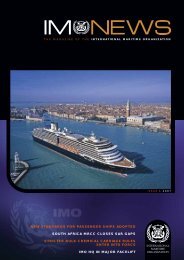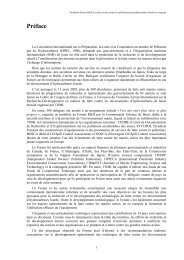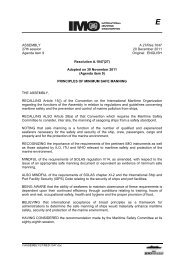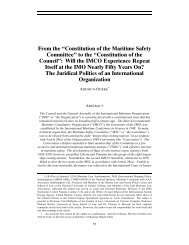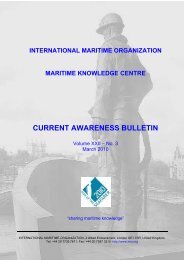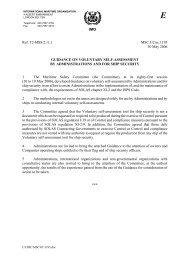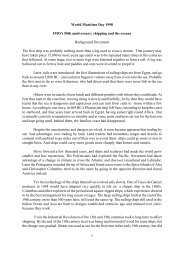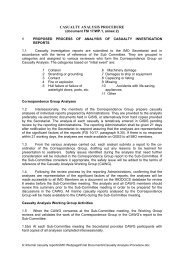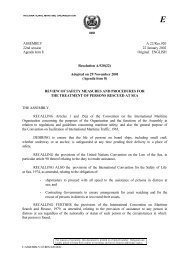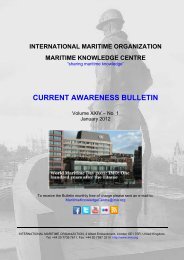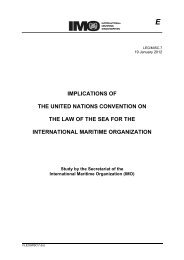Radioactive Waste Disposal at Sea: Public Ideas ... - IMO
Radioactive Waste Disposal at Sea: Public Ideas ... - IMO
Radioactive Waste Disposal at Sea: Public Ideas ... - IMO
Create successful ePaper yourself
Turn your PDF publications into a flip-book with our unique Google optimized e-Paper software.
Conclusion 177<br />
nomic arrangements onto the world” (Burley 1993, p. 125). When examined<br />
<strong>at</strong> the level of st<strong>at</strong>es, r<strong>at</strong>her than the level of transn<strong>at</strong>ional actors, this<br />
case shows th<strong>at</strong> the hegemon achieved a regime serving its combined environmental,<br />
economic, and political interests. In the final analysis, therefore,<br />
this regime grew out of a self-initi<strong>at</strong>ed regul<strong>at</strong>ory change in the United<br />
St<strong>at</strong>es. At the intergovernmental level, the case therefore could suggest a<br />
hegemonic explan<strong>at</strong>ion for the very existence of this global environmental<br />
regime.<br />
Yet the hegemon cre<strong>at</strong>ed the regime neither through military force nor<br />
by offering rewards or side payments; instead, it projected the politically<br />
constructed r<strong>at</strong>ionale for domestic regul<strong>at</strong>ion onto the intern<strong>at</strong>ional level.<br />
Similar to the domestic-level process in the United St<strong>at</strong>es, policy entrepreneurs<br />
pushed a powerful public idea (the “dying oceans” idea) identifying<br />
a seemingly evident and indisputable need for intern<strong>at</strong>ional<br />
environmental regul<strong>at</strong>ion. U.S. leadership was of an ide<strong>at</strong>ional n<strong>at</strong>ure,<br />
and it seems best captured by a concept of hegemony stressing m<strong>at</strong>erial<br />
and structural resources as well as cultural norms. The Gramscian concept<br />
of hegemony in particular emphasizes the hegemonic st<strong>at</strong>e’s ability to<br />
maintain cohesion and identity within a core group of st<strong>at</strong>es through the<br />
propag<strong>at</strong>ion of a common culture. 3 In addition, this concept of hegemony<br />
envisions th<strong>at</strong> intern<strong>at</strong>ional organiz<strong>at</strong>ions, such as the United N<strong>at</strong>ions,<br />
assist in spreading and consolid<strong>at</strong>ing values and norms of the hegemon.<br />
Accordingly, the Gramscian concept of hegemony can also account well<br />
for the important role the Stockholm secretari<strong>at</strong> played during the process<br />
of regime establishment.<br />
Though it is neither possible nor advisable to draw broad generaliz<strong>at</strong>ions<br />
on the basis of a single-case study, it is not too difficult to point to other<br />
examples of such U.S. leadership and hegemony in a nonm<strong>at</strong>erial, ide<strong>at</strong>ional<br />
sense in the environmental field. For example, a former U.S. ambassador to<br />
the United N<strong>at</strong>ions had such ide<strong>at</strong>ional hegemony in mind when he<br />
observed, as mentioned in chapter 6, th<strong>at</strong> the U.S. government and<br />
American elite groups in the early 1970s had become gre<strong>at</strong> producers and<br />
distributors of world environmental crises. Examples also exist in other policy<br />
fields. In the area of macroeconomic policy, for example, the United<br />
St<strong>at</strong>es spread Keynes’s economic ideas to other countries after World War<br />
II. Stressing American military and economic dominance <strong>at</strong> th<strong>at</strong> point,<br />
Hirschman generalizes this hegemon-initi<strong>at</strong>ed ideas process as follows



